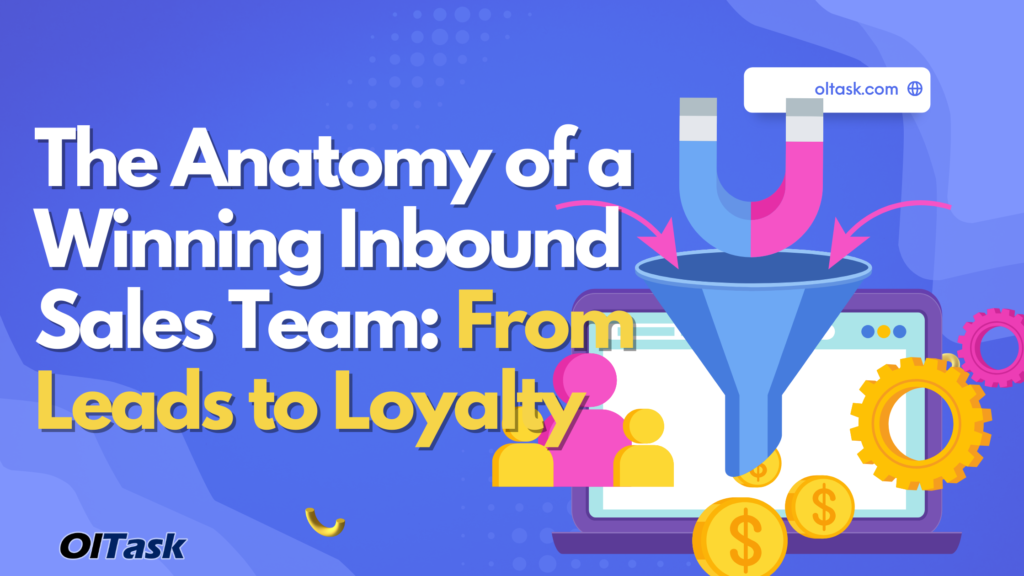The Anatomy of a Winning Inbound Sales Team: From Leads to Loyalty

Inbound sales teams are pivotal in propelling revenue generation, transcending the stereotype of being mere call receivers.
This comprehensive guide delves into what an inbound sales team is, exploring the essential components that compose a triumphant inbound sales team.
We draw inspiration from OlTask’s proven approach and delve into the pivotal elements that guarantee success, encompassing not only team structure but also the strategies that power their effectiveness.
As we journey through this exploration, you’ll gain valuable insights and actionable strategies to reshape your inbound sales team for exceptional results and lasting success.
What is an Inbound Sales Team?: Building an Effective Inbound Sales Team

Inbound sales teams play a pivotal role in revenue generation, transcending the stereotype of being mere call receivers. In this section, we explore the crucial components, strategies, and practices that underpin a successful inbound sales team.
Team Structure
In the intricate web of inbound sales, a well-structured team is the foundation of success. This section dissects the anatomy of an effective team, highlighting role clarity, cross-functional collaboration, and the nurturing of talent through leadership and mentorship.
- Clear Delineation of Roles and Responsibilities: Inbound teams thrive when each member understands their specific tasks and responsibilities, ensuring efficiency and preventing overlaps.
- Collaboration Between Sales, Marketing, and Support Teams: Seamless communication and cooperation between these departments facilitate lead handover, align messaging, and provide a holistic customer experience.
- Leadership and Mentorship for Skill Development: Strong leadership fosters a culture of growth. Experienced team members serve as mentors, nurturing skills and elevating the overall team performance.
Inbound Strategy
A robust inbound strategy serves as the solid foundation for a successful sales team. This strategy is constructed upon three essential pillars, each playing a crucial role in achieving sales excellence.
- Customer-Centric Approach: Putting the customer at the center of your strategy ensures that their needs and preferences guide your interactions, leading to more meaningful engagements.
- Data-Driven Decision-Making: Leveraging data analytics enables you to make informed decisions, refine your approach, and continuously improve your strategies.
- Tailored Content for Lead Nurturing: Creating and delivering content that addresses the specific needs and pain points of your leads is crucial for building relationships and trust throughout the buyer’s journey.
Effective Communication
Effective communication is the lifeblood of any successful inbound sales team. It encompasses various aspects crucial for building strong customer relationships and driving revenue. Here’s a closer look.
- Interdepartmental Communication: Collaboration and open communication between sales, marketing, and support teams are vital. Sharing insights and feedback ensures a unified approach and consistent customer experience.
- Engaging with Leads Promptly: Timeliness is key in the world of inbound sales. Responding promptly to leads’ inquiries and showing genuine interest in their needs can significantly impact conversion rates.
- Active Listening and Empathy: Understanding and empathizing with the challenges and needs of potential customers build trust and rapport. Active listening skills enable agents to tailor solutions effectively.
Continuous Training
Continuous training is the cornerstone of a high-performing inbound sales team. It ensures agents stay agile, informed, and adept in using cutting-edge tools and techniques. Here’s a closer look.
- Ongoing Skill Development: Inbound agents must continually refine their sales and communication skills. Regular training sessions and workshops enable them to stay at the top of their game.
- Keeping Up with Industry Trends: The sales landscape evolves rapidly. Agents need to stay updated with industry trends, customer preferences, and emerging technologies to remain competitive.
- Technology and Tools Proficiency: Proficiency in the tools and technologies used in sales and marketing is paramount. Regular training ensures that agents can leverage these resources effectively to drive results.
Performance Metrics
Performance metrics serve as the guiding light for an inbound sales team, illuminating the path to success. These metrics encompass various key performance indicators (KPIs), enabling the team to consistently evaluate and enhance their strategies. Regular feedback and data-driven insights further refine their approach, ensuring continuous growth and achievement of sales objectives.
- Key Performance Indicators (KPIs): These measurable values track progress toward sales goals and help agents stay on course.
- Regular Assessment and Feedback: Continuous evaluation of individual and team performance provides insights for improvement.
- Adjusting Strategies Based on Data: Data-driven decisions allow the team to refine strategies for better results and higher efficiency.
Developing an Inbound Strategy

The success of an inbound sales team hinges on its ability to understand and cater to the buyer’s journey. This journey encompasses three main stages: awareness, consideration, and decision-making.
Awareness
In the initial awareness stage, potential customers recognize a problem or need. Your team’s goal is to provide valuable, educational content that addresses these concerns and positions your brand as a trusted resource.
- Educational Content: Create blog posts, videos, or guides that address common pain points and challenges your target audience faces.
- Keyword Research: Use SEO to ensure your content appears when prospects search for solutions online.
- Social Media Engagement: Share informative content on platforms where your audience spends time.
- Lead Generation: Capture leads through forms or subscriptions to build your email list.
- Email Campaigns: Nurture leads with informative email sequences that guide them through the awareness stage.
- Tracking Analytics: Monitor engagement metrics to assess content effectiveness and identify areas for improvement.
Consideration
The consideration stage is where prospects actively seek solutions to their problem. Your inbound sales team should offer targeted content that showcases your product or service’s benefits, helping leads evaluate their options.
- Comparative Content: Develop content that highlights your product or service’s unique features and advantages compared to competitors.
- Webinars and Demos: Host webinars or offer product demonstrations to showcase your solution’s value.
- Email Personalization: Tailor email communication based on prospects’ preferences and behaviors.
- Lead Scoring: Implement lead scoring to prioritize prospects who are most likely to convert.
- Multichannel Engagement: Engage through various channels like email, social media, and webinars.
Decision-Making
In the decision-making stage, leads are ready to make a purchase. Your team’s role is to provide tailored information, address objections, and guide them toward choosing your solution as the best fit for their needs.
- Customized Proposals: Provide tailored proposals and pricing information based on prospects’ specific needs.
- Direct Communication: Offer one-on-one consultations or product walkthroughs.
- Handling Objections: Address concerns and objections transparently, focusing on value and benefits.
- Leverage Reviews and Testimonials: Share customer testimonials and reviews to build trust.
- Sales Team Collaboration: Ensure close collaboration between sales, marketing, and support teams for a seamless transition from lead to customer.
- Follow-Up: Implement a strategic follow-up process to nurture leads who are not yet ready to make a decision.
The Sales Funnel and Lead Nurturing

The sales funnel and effective lead nurturing are the linchpins of a successful inbound sales strategy. Understanding the intricacies of each stage and how to guide prospects through them is essential for maximizing conversions.
Sales Funnel
The sales funnel is a fundamental concept in inbound sales, representing the journey prospects take from awareness to decision-making. Understanding its stages, lead movement, content alignment, and metrics tracking is crucial for successful conversions.
- Top of Funnel (TOFU): Awareness stage where prospects discover your brand and offerings.
- Middle of Funnel (MOFU): Consideration stage, where prospects evaluate options and consider solutions.
- Bottom of Funnel (BOFU): Decision-making stage, where prospects convert into customers.
- Lead Movement: Ensure a smooth transition from one stage to the next, nurturing prospects along the way.
- Content Alignment: Tailor content to each funnel stage, addressing prospects’ evolving needs.
- Metrics Tracking: Monitor conversion rates at each stage to identify bottlenecks and optimize the funnel.
Lead Nurturing
Lead nurturing is the art of cultivating prospects into loyal customers through personalized approaches, automated workflows, scoring, segmentation, drip campaigns, multi-channel engagement, feedback loops, and continuous optimization. Discover how these strategies drive conversions.
- Personalization: Craft personalized email sequences and content based on prospect behavior and preferences.
- Automated Workflows: Use marketing automation to send timely and relevant messages to nurture leads.
- Scoring and Segmentation: Assign scores to leads based on their engagement and segment them for targeted nurturing.
- Drip Campaigns: Create drip email campaigns to gradually educate and engage prospects.
- Multi-Channel Approach: Engage leads through various channels like email, social media, webinars, and more.
- Feedback Loops: Gather feedback from leads to refine nurturing strategies.
- Continuous Optimization: Regularly assess and adjust nurturing workflows to improve lead conversion rates.
Analytics and Continuous Improvement
Analytics and continuous improvement are the engines propelling inbound sales success and are essential for achieving optimal results in what an inbound sales team is. Through data-driven insights, frequent evaluation, and iterative refinement, sales teams optimize strategies, enhance performance, and steer towards higher conversion rates.
- Data-Driven Insights: Harness data analytics to gain deep insights into prospect behavior, preferences, and conversion patterns.
- Regular Performance Assessment: Continuously evaluate sales team performance, identifying strengths and areas for improvement.
- Iterative Refinement: Implement changes based on data insights, refine strategies, messaging, and targeting for better results.
Crafting an exceptional inbound sales team, with a structured approach, customer-centric strategy, communication, training, metrics, and inbound strategy, drives revenue growth. Whether you’re wondering what an inbound sales team is or seeking to enhance your existing one, this guide provides invaluable insights and actionable strategies to ensure your team remains agile, adaptable, and primed for peak performance.
Build Your Winning Inbound Sales Team

Are you ready to elevate your revenue and transform your sales team into a powerhouse of success? At OlTask, we specialize in crafting exceptional inbound sales teams that generate results. Your success story begins with us – take the first step towards a winning inbound sales team that will drive your business to new heights. Contact our team today, and let’s embark on a journey to unlock your business’s full sales potential.